
Ontario’s public service heads back to the office, meaning more traffic and emissions
For 15 years and counting, my commute from Mississauga to Toronto has been mired by...
SMITHERS, B.C. (Wet’suwet’en territory) — As the wind picks up and lashes icy rain from clouds that threaten to swallow the subalpine landscape, Sybille Haeussler and Alana Clason stride up a hill known locally as Toboggan Hill on Dzilh Yez, or Hudson Bay Mountain, in Smithers, B.C.
Clason points out a scraggly mid-sized tree at the top of a rocky knoll. “It’s a bit like an upside down toilet brush,” she says.
The tree is whitebark pine, the first and only tree in Western Canada to be designated an endangered species and the only coniferous tree in the country with the designation. Facing the combined threats of habitat loss, climate change, the mountain pine beetle and an invasive fungus called blister rust, the tree was added to the federal endangered species register under the Species At Risk Act in 2012.
Haeussler and Clason are part of a team of researchers at the Bulkley Valley Research Centre studying the tree with the goal of preventing its extinction.
Haeussler, a semi-retired forester and ecologist, first became aware of the plight of whitebark pine in the 1980s and later chose it as a model species for her work on resilience and cumulative effects. A species in decline makes for good data. “We scientists are really prone to that — I can study this thing dying,” she says, looking at the ground through black-rimmed glasses while she talks. A battered ball cap keeps her hair away from her face. “But after about two years, I said, ‘No way, I want to do something to save the tree.’ ”
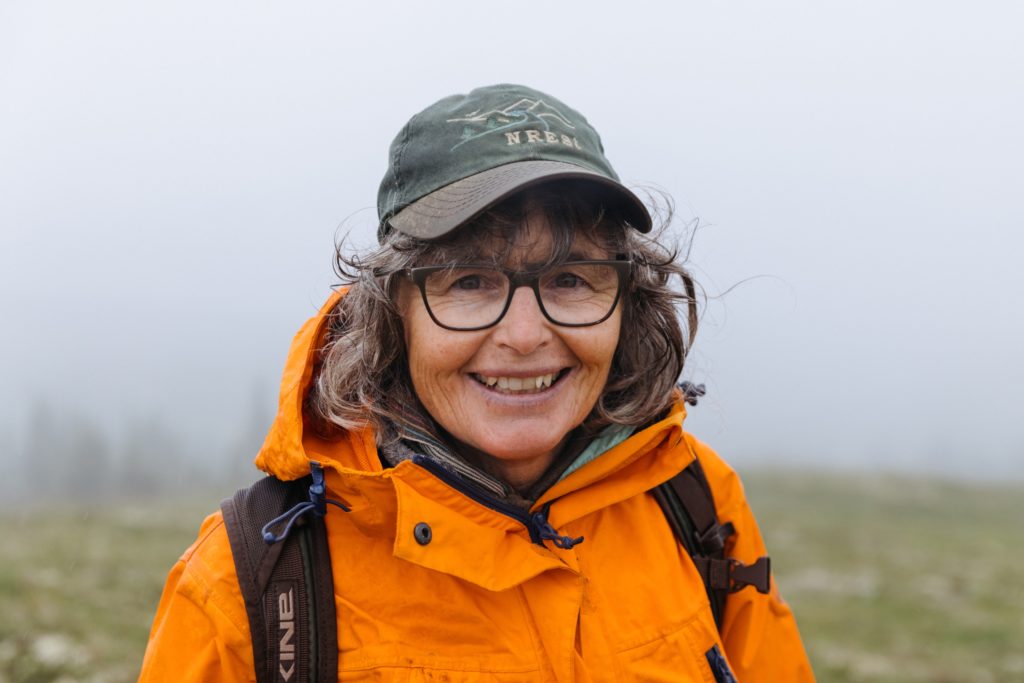
Forester and ecologist Sybille Haeussler. Photo: Marty Clemens

Mountain ecosystems ecologist Alana Clason. Photo: Marty Clemens
Clason, a mountain ecosystems ecologist, became interested in the tree while studying under Haeussler as a master’s student. It’s August, but she’s wearing a toque and is bundled in several layers. The wind tears at her jacket.
“It started with me being interested because it was a high-elevation tree and I liked being in the mountains,” she says. “It became my life’s passion because of the ecosystem, but also just Sybille inspiring that love of how important that system is.”
We’re here on the mountain to visit test restoration sites on the edge of the alpine prairie, where Haeussler, Clason and other researchers have planted whitebark seeds and seedlings to study their resilience at their northern limit and to gain a deeper understanding of how some trees are rust resistant.
Whitebark pine’s natural range in Canada extends from the U.S. border to here and from the Coast Mountains in B.C. to the foothills of the Rocky Mountains in Alberta.
“Whitebark pine is a tree that does not tolerate heat and thrives in open, typically harsh conditions where it doesn’t have to compete with other tree species,” Haeussler says.
And whitebark pine does have advantages over other trees. It can grow right on the edge of the alpine, withstanding brutal weather conditions, and on landscapes where there are recurrent outbreaks of fire and bark beetles.
“Whitebark pine, like all pines, is a tree that thrives on disturbance,” Haeussler says.
“It’s just such a badass tree,” Clason says, crouching down on a rocky slope, looking at a tiny seedling. “Who wants to grow here? There’s hardly any soil. And it’s just like, ‘Yeah, I can do it.’ ”
As Haeussler leads the way at a brisk pace higher into the alpine, she says getting the tree recognized as endangered was not an easy process. When researchers first tried to call attention to the situation in the early 1990s, government capacity to address the issue was severely limited.
“The ministry forest service is very focused on commercial trees,” she says. “So a tree that doesn’t have any commercial value was at that point the responsibility of the Ministry of Environment. And the Ministry of Environment is full of wildlife people.”
Clason says not much has changed since the tree was declared endangered. Within government, people who want to help protect species often have to engage with researchers “from the sides of their desks.”
“It is definitely still an issue of falling between the cracks,” she says as she follows Haeussler up through the subalpine.
Clason says it’s hard to get people to care about something that’s not cute and cuddly. Then she suddenly reaches down, grinning, and gently touches another seedling poking out from under the branches of a larger tree. “But just look at it — how could you not think that’s cute?”
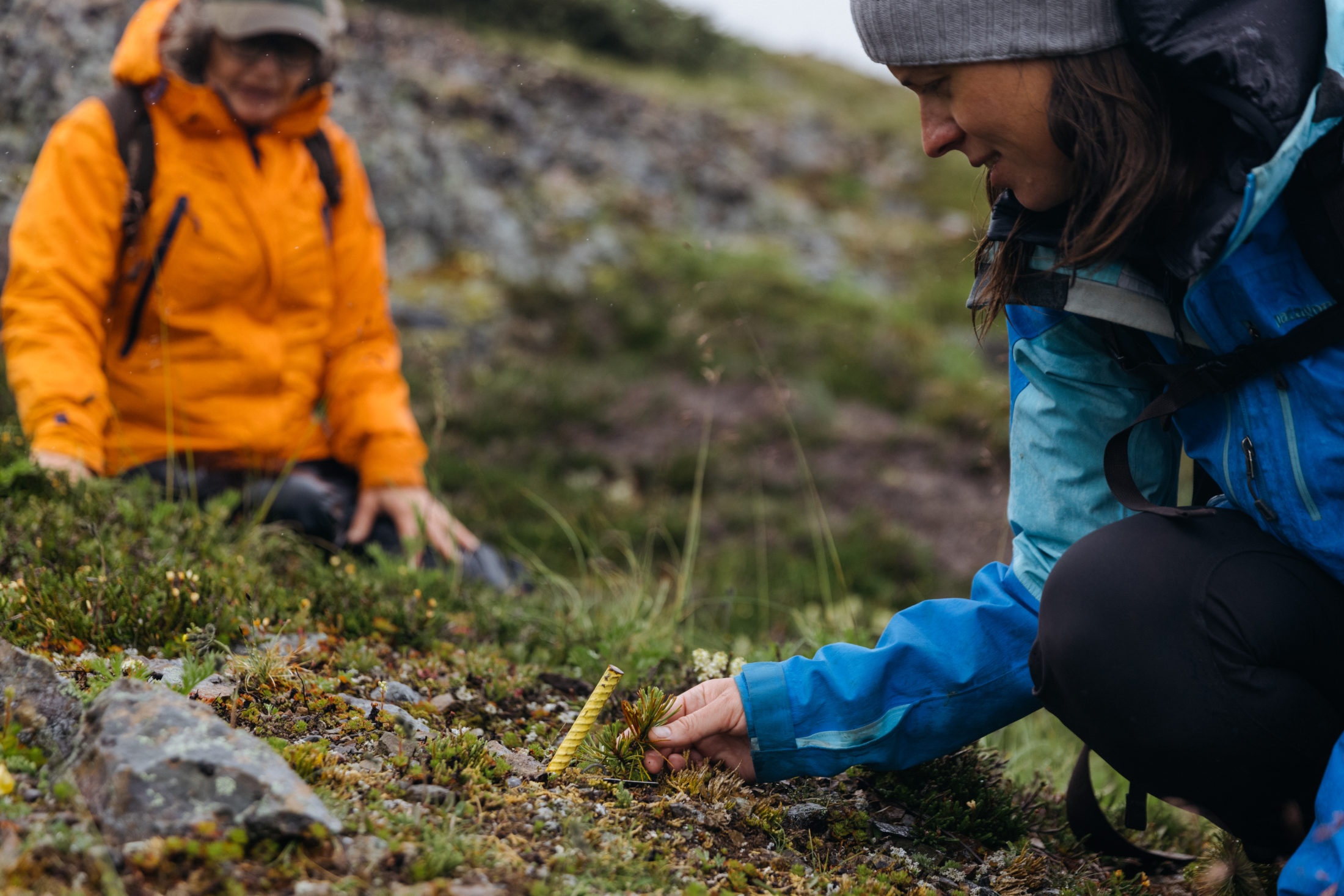
Alana Clason checks out a whitebark pine seedling while Sybille Haeussler looks on. Photo: Marty Clemens / The Narwhal
Haeussler explains it was the mountain pine beetle outbreak in the early 2000s that finally pushed whitebark pine conservation to the forefront.
Because the pine beetle can’t survive near the alpine, trees in the mountain environment might represent the best hope for future conservation efforts. But because of the harsh weather conditions they endure, these trees are stunted and their cones are typically smaller.
“That’s one of the really sad things about the mountain pine beetle,” Haeussler says. “It took out almost all of the low-elevation stands, which is where the trees are bigger and they produce a ton of cones and the seeds are way better.”
While the mountain pine beetle finally put the tree on officials’ radar, it has been under attack for much longer. Climate change has impacted whitebark pine since the early 1800s, Haeussler says, and blister rust has been attacking the tree for at least 50 years. “There wasn’t a magical date when everything suddenly began to fall apart. This crisis has been building for a very long time.”
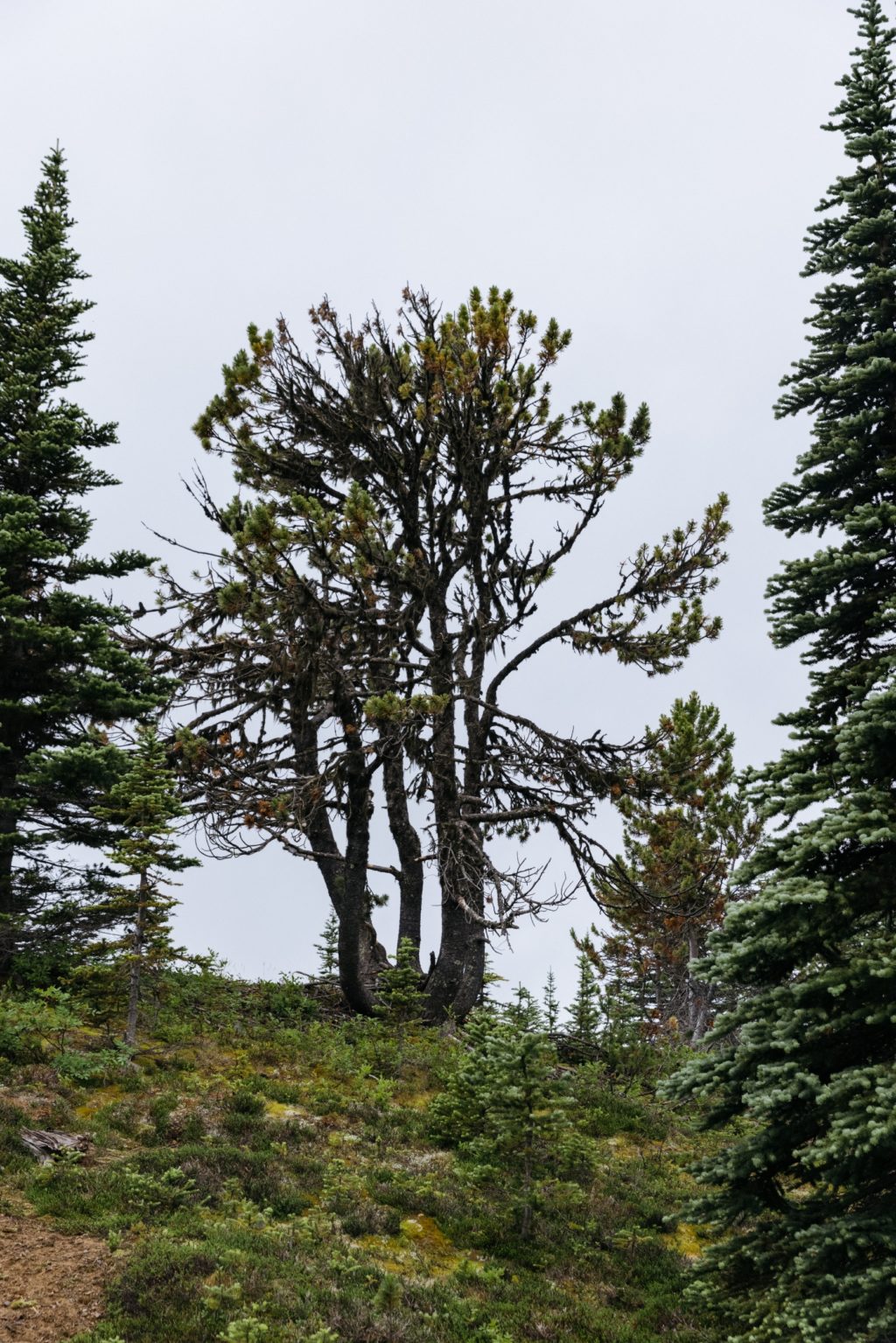
A healthy whitebark pine stands on Dzilh Yez in Smithers, B.C. Photo: Marty Clemens / The Narwhal
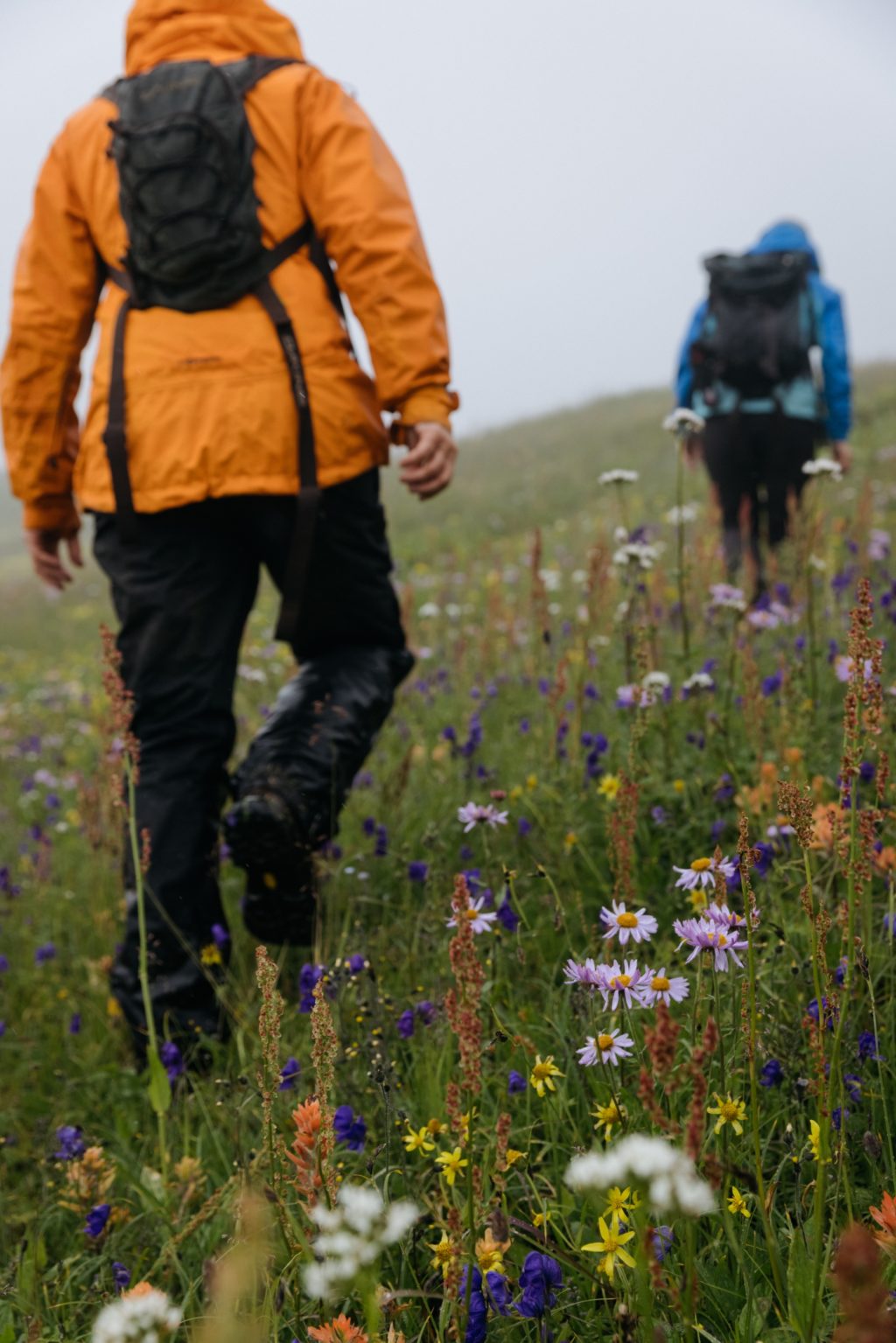
Blister rust requires an alternate host to whitebark pine to survive — a red wildflower called Indian paintbrush. Photo: Marty Clemens / The Narwhal
As climate change continues to create warmer environments at higher elevations, other conifer species spread and compete with the tree for habitat.
“These other faster-growing tree species are going to move up that slope and sort of squish out those places where whitebark has been able to eke an advantage,” Clason explains.
Forestry management practices like fire suppression have also reduced areas where whitebark pine can find an advantage over competing species. After a wildfire, whitebark pine is one of the first trees to take root. The open spaces created by natural fires in the subalpine are ideal for the sun-worshipping tree. Preventing or limiting natural fire events means there are fewer places where the tree is able to repopulate the landscape.
As whitebark habitat dwindles, the disease attacking it continues to spread. The invasive fungus originally came from Asia, first travelling across Europe and reaching North America in the early 1900s.
Unlike the mountain pine beetle, blister rust is indifferent to elevation. However, it needs an alternate host to survive. In the subalpine, that’s a wildflower.
The weather clears briefly and Haeussler stops to take photos of the subalpine landscape, saying she’ll be guiding a group of naturalists here the following day. Clason points out examples of the flower. It’s a showy red wildflower and there are plenty of them, punctuating the meadows of green and yellow and purple that descend down the slope toward the timberline.
Blister rust has a more profound impact on North American trees than on its Asian counterparts, which have evolved to withstand it. “They still get diseased, but it doesn’t kill them,” Haeussler says of the Asian trees.
With North American whitebark pine on a precipitous decline, there’s no time to wait to see if the species can adapt to the fungus.
Haeussler and Clason’s work through the Bulkley Valley Research Centre involves collecting and studying seeds to identify trees that are rust resistant and then trying to propagate healthy trees on restoration plots.
“We’re just trying to help evolution move a little bit quicker,” Clason says.
One method the researchers use is finding healthy trees in stands where all the other trees are infected. Seeds from those trees have a good chance of producing rust-resistant seedlings.
Good sample sites are generally remote in northwest B.C., so helicopters are typically used to access the areas and professional arborists are employed to collect the cones. In the past, Haeussler and her team would canoe and hike to collection sites, sometimes camping in the bush, and one of her colleagues would climb the trees to access the best seeds.
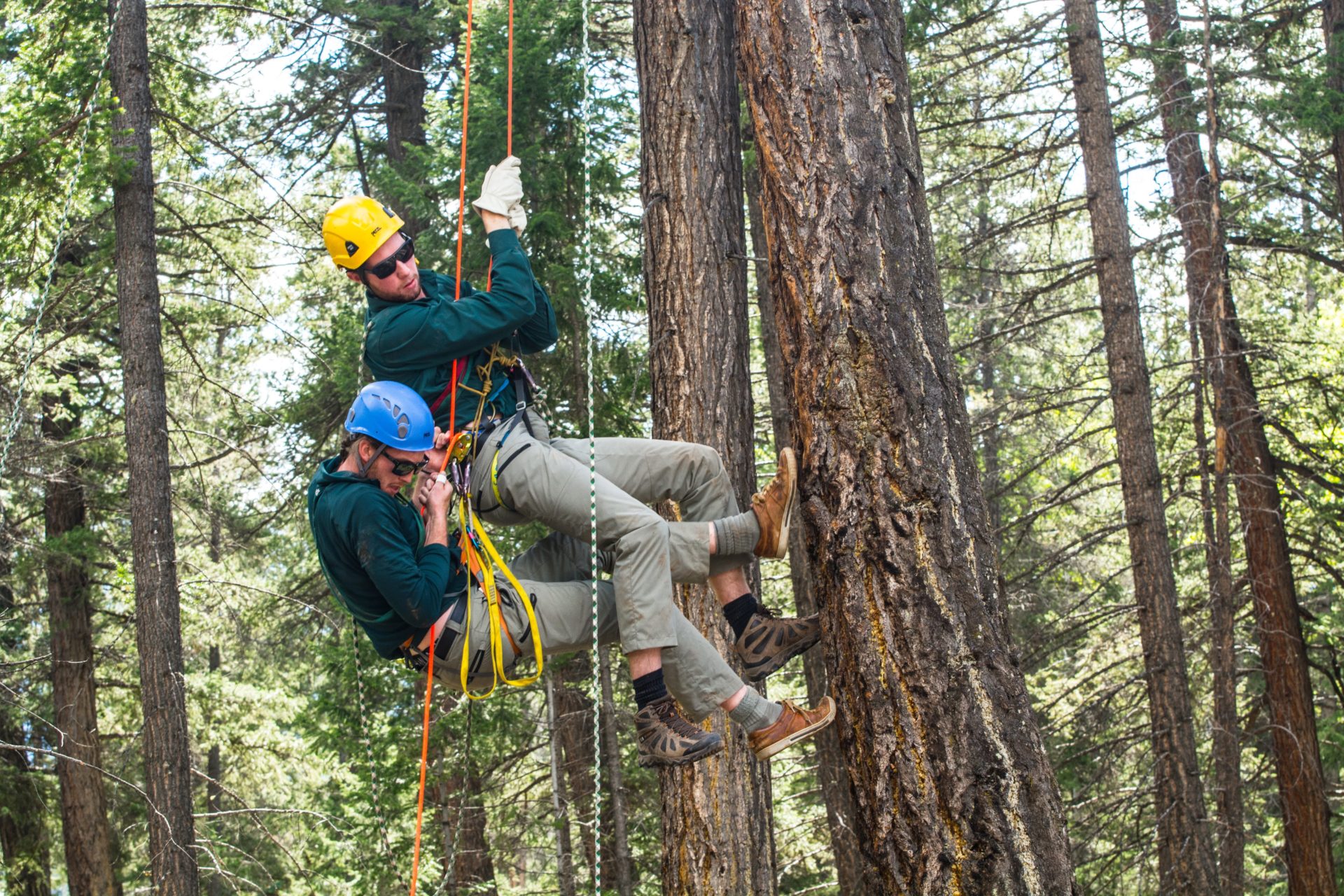
Learning the ropes: members of a field crew learn how scale tall trees to collect cones. Photo: Iain Reid
Another method the researchers use is planting seeds and exposing seedlings to the fungus. If they survive, seeds from the parent trees can be considered viable for restoration planting projects.
One of the goals of Haeussler and Clason’s work is to collect enough viable seeds to replant stands in areas the trees might have a chance of surviving. Once mature — about 40 to 50 years — these stands can then provide new seeds for future restoration work.
But whitebark pine trees produce seeds less frequently than most conifers, and predicting which years will be good is almost impossible.
“We had a good year in 2018,” Haeussler says. “It was pretty much a good year across the province. We collected around 700,000 seeds. It sounds like a lot, but if you were collecting from another species, you’d get millions.”
Planting test restoration plots, like the one we’re here to see, serves several purposes. Some are intended strictly to gather data, not to see the trees mature, but Clason and Hauessler have also planted seedlings they hope will survive. On this mountain alone, the research centre has planted four restoration plots, with another in a cutblock not far away.
Haeussler and Clason aren’t the only ones working on whitebark pine restoration. Other ecologists, geneticists and tree pathologists from B.C., Alberta and the U.S. are also closely studying the species.
“Just like in the ecosystem, where there are many moving parts that interact together, the same is true of the people who are trying to save it,” Clason says. “We come from a number of different disciplines, but it’s through working together that we’ll figure out how to hopefully contribute to keeping whitebark pine and all the pieces of the ecosystem around for a long time.”
Because whitebark pine conservation is a race against time, Clason says, researchers funded by Parks Canada and supported by other organizations are developing “seed orchards.”
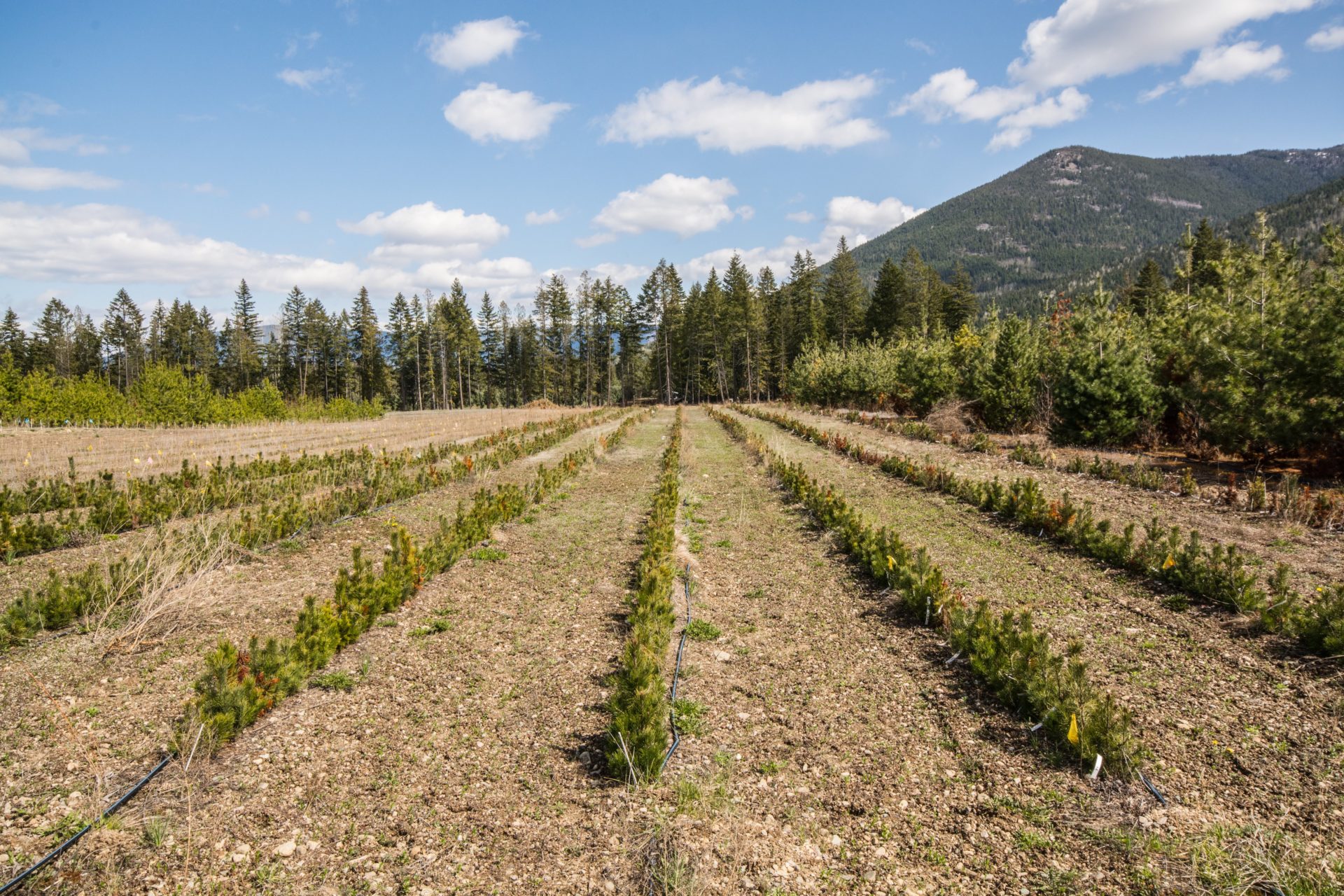
Whitebark seedlings growing in a nursery near Salmon Arm, B.C., may hold key to survival of the endangered species. Photo: Iain Reid
When a tree is found to be rust resistant, instead of simply taking its seeds, researchers cut off a branch and use that to grow a new tree, much in the same way apple trees are grown. The goal is to get the trees to produce seeds as quickly as possible. To further speed up the process, researchers put the trees under stress by, for instance, girdling them and depriving them of moisture at specific times.
“It’s gnarly — they do all sorts of things to them,” Clason says. “It looks like the trees [have been in] torture chambers, because trees produce tons of cones when they’re stressed. They look awful, but they produce seeds like crazy.”
Understanding whitebark pine means understanding its role and interactions within the ecosystem. Because the tree often grows on steep, exposed, rocky ridges, its roots stabilize those slopes and help build up snowdrifts, which melt more slowly than the rest of the snowpack. This means that melt can help sustain other subalpine species such as lichens, grasses and wildflowers, and reduce flooding events at lower elevations.
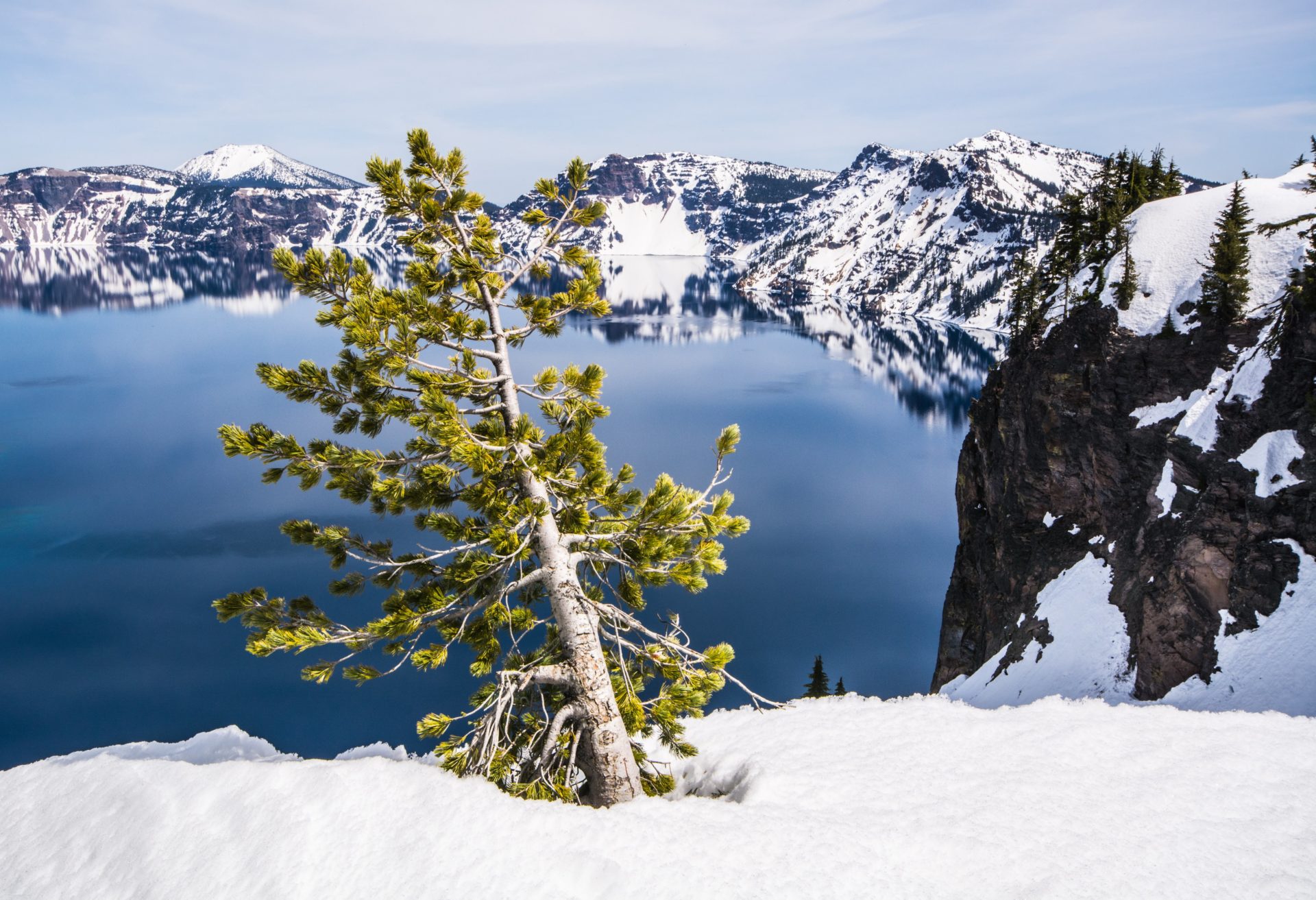
Whitebark pine help stabilize slopes and build up snowdrifts. Photo: Iain Reid
And while most conifers suffer if they lose needles, whitebark pine is happy to shed its needles. Over time, they build up and serve as bedding under the shelter of the tree’s branches for wildlife such as deer and mountain sheep.
But the real star of the whitebark pine story is its seeds.
Unlike most of its coniferous cousins, whitebark pine seeds are not dispersed by wind or fire. Instead, their dispersal is almost exclusively dependent on a single bird: Clark’s nutcracker.
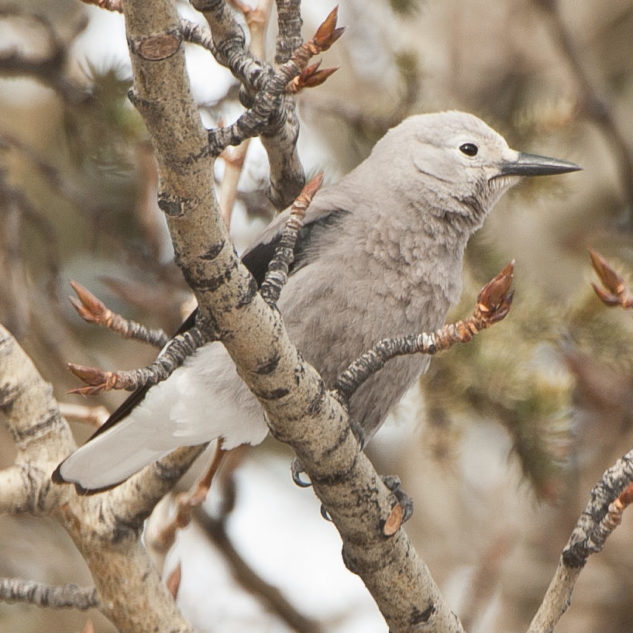
The Clark’s nutcracker uses its long, slender beak to break open whitebark pinecones and remove the seeds. Photo: H. Loney Dickson / The Narwhal
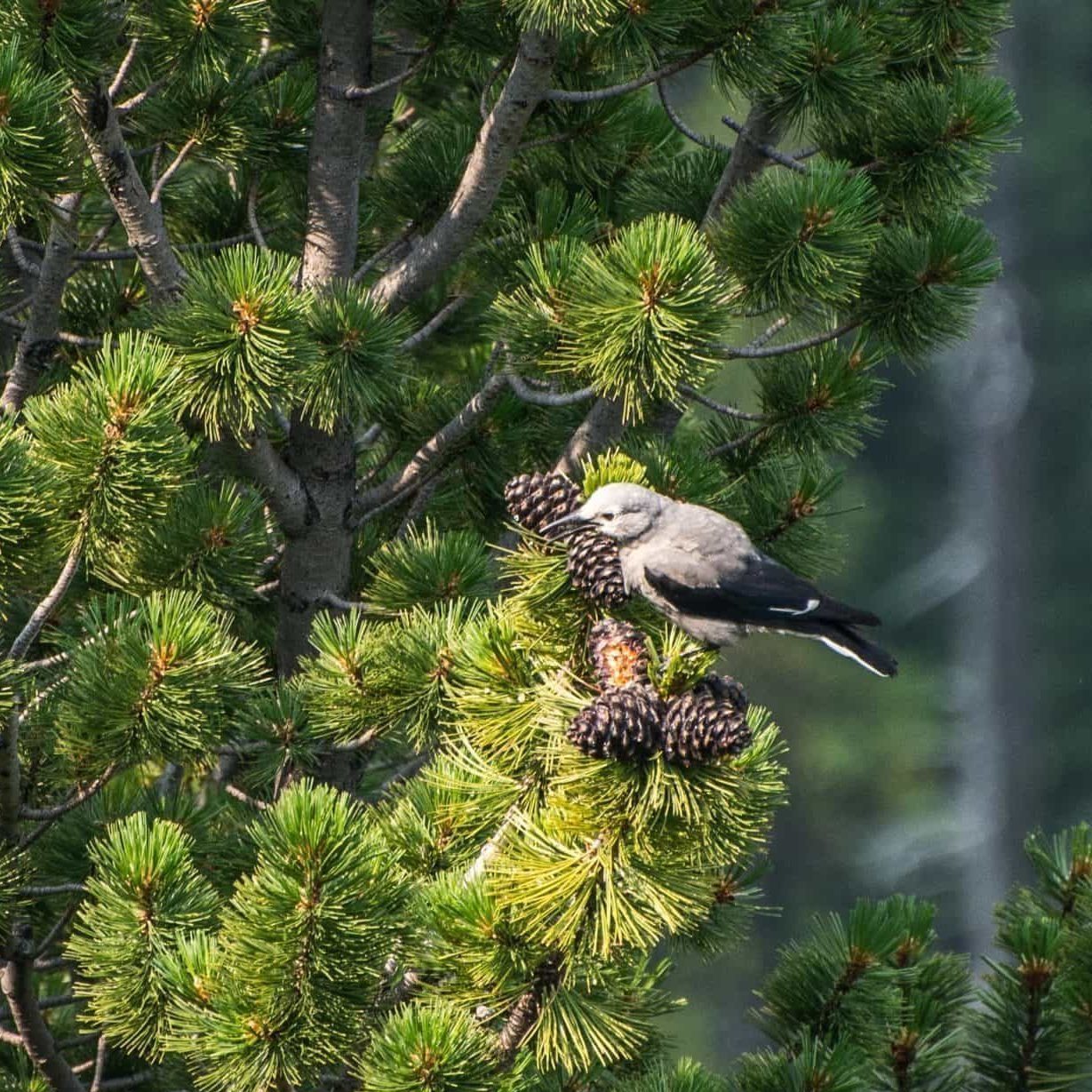
A Clark’s nutcracker perches beside pinecones on a healthy whitebark pine. Photo: Iain Reid
“It cracks open the seeds in the cones and flies away and caches them,” Clason says. “Nutcrackers are in the corvid family, so they have this incredible memory. They’re able to go back and retrace their steps and find those caches, and then feed the seeds to their young.”
However, about half of the protein-packed seeds, which are about the size of a pea, are forgotten and many of them grow into seedlings.
Clason points to a mature tree, where the upturned tips of the branches hold the cones. “These are little landing pads where the bird can come and snag the seed.”
Just a few feet away, a little seedling is growing out of a lichen-covered rocky slope. “It’s hard to get your head around that it was probably a nutcracker that did this and not just the wind.”
The bird isn’t the only creature that eats whitebark seeds. Clason says the tree “feeds this entire web of critters that love it, from the nutcracker that it completely relies on for its dispersal to grizzly bears and black bears.”
“We’ll see whole branches ripped off because bears will climb the trees. They just love the seeds so much. Squirrels create huge middens — the bears will also help themselves to that. These incredibly fatty, rich seeds feed a whole network. It’s just this really intricate and complex and beautiful system.”
Haeussler and Clason say to adequately address conservation concerns, considering the ecosystem in its entirety is essential.

Alana Clason examines a whitebark pine. Photo: Marty Clemens / The Narwhal
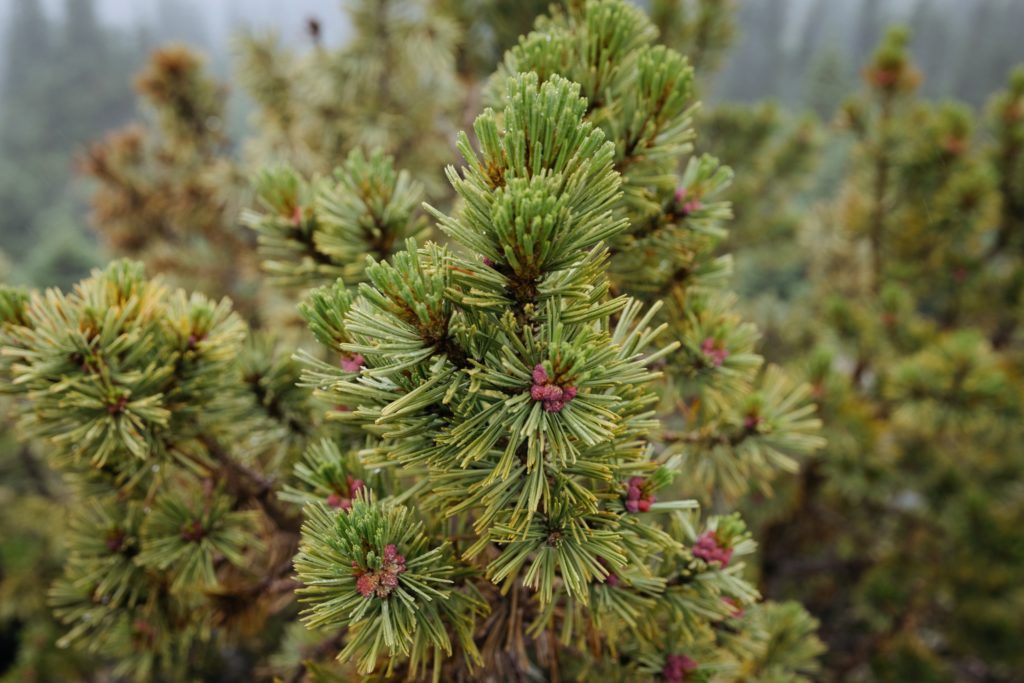
Researchers are collecting whitebark pinecones and studying the seeds in hopes of finding trees that are rust resistant. Photo: Marty Clemens / The Narwhal
“If we focus only on helping the tree move more quickly to develop rust resistance, but we don’t spend any time thinking about where we want the system to stay intact, then we’re going to break that connection between whitebark and Clark’s nutcracker,” Clason says. And if that breaks, then we’ve kind of lost the system.”
The northern limit, where conditions are colder, is a landscape where whitebark pine may have a chance of surviving as the climate continues to warm.
But the tree can only expand its range if the bird goes with it. And the bird requires other food sources to survive, such as insects and berries, which could be difficult to find north of its current range.
Forecasting climate change means considering all the potential effects on the ecosystem, including on the wildlife and other tree species. And yet, thus far, Haeussler and Clason have been unable to get funding to study the nutcracker.
Despite its status as an endangered species, whitebark pine is also still being logged. As The Narwhal reported last year, since achieving its official designation as endangered in 2012, more than 19,000 cubic metres of whitebark pine have been logged in B.C.
The problem boils down to a jurisdictional issue. While the tree is now federally protected, provinces have to develop management and recovery plans, which can take many years. Both the B.C. Ministry of Forests and Ministry of Environment told The Narwhal there are no such plans in place. In Alberta, whitebark pine is protected in large sections through the province’s national parks and any logging of the tree has to be done with the permission of the Ministry of Environment and Parks.
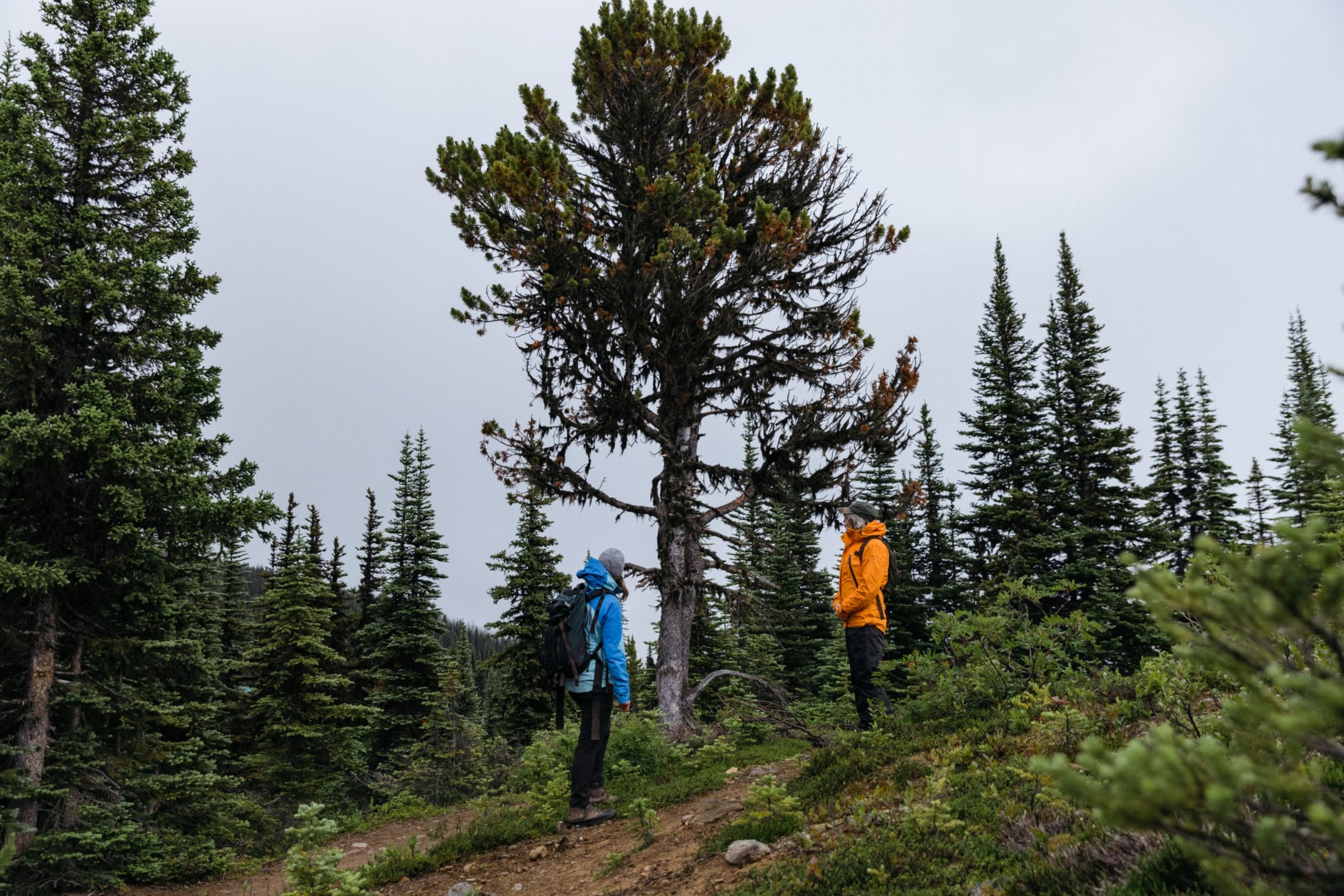
Researchers Alana Clason, left, and Sybille Haeussler examine a whitebark pine on Dzilh Yez in Smithers, B.C. Photo: Marty Clemens / The Narwhal
Last fall, whitebark pine trees were cut down to make way for the Coastal GasLink pipeline. The company was required to collect the cones from felled trees so viable seeds could be used in replanting projects, but in June it was served a stop-work order by the Environmental Assessment Office for failing to do so.
Coastal GasLink will now likely purchase viable seeds from the BC Tree Seed Centre, a seed storage facility in Surrey, according to Haeussler and Clason. Most of the seeds the researchers collect are sent to that facility, where they can be safely kept for 10 to 25 years.
The test restoration plot is perched on a barren slope. Little seedlings poke innocuously out of the tundra, tagged with metal identification plates. Some of the trees didn’t make it — all that’s left is an ID number lying on the ground. This particular plot was planted by a UBC graduate student for a genetic study on rust resistance.
Haeussler points out places on the landscape where whitebark pine is likely to thrive — rocky outcroppings where other conifer trees can’t grow. She leads us to one likely location, just down the slope from the restoration plot, and we find a mature tree already suffering the effects of blister rust. The tree is bursting with vivid purple pollen cones.
“The tree is under quite a bit of stress because it’s dying of blister,” Haeussler says, as Clason searches its trunk for the telltale orange fungus.
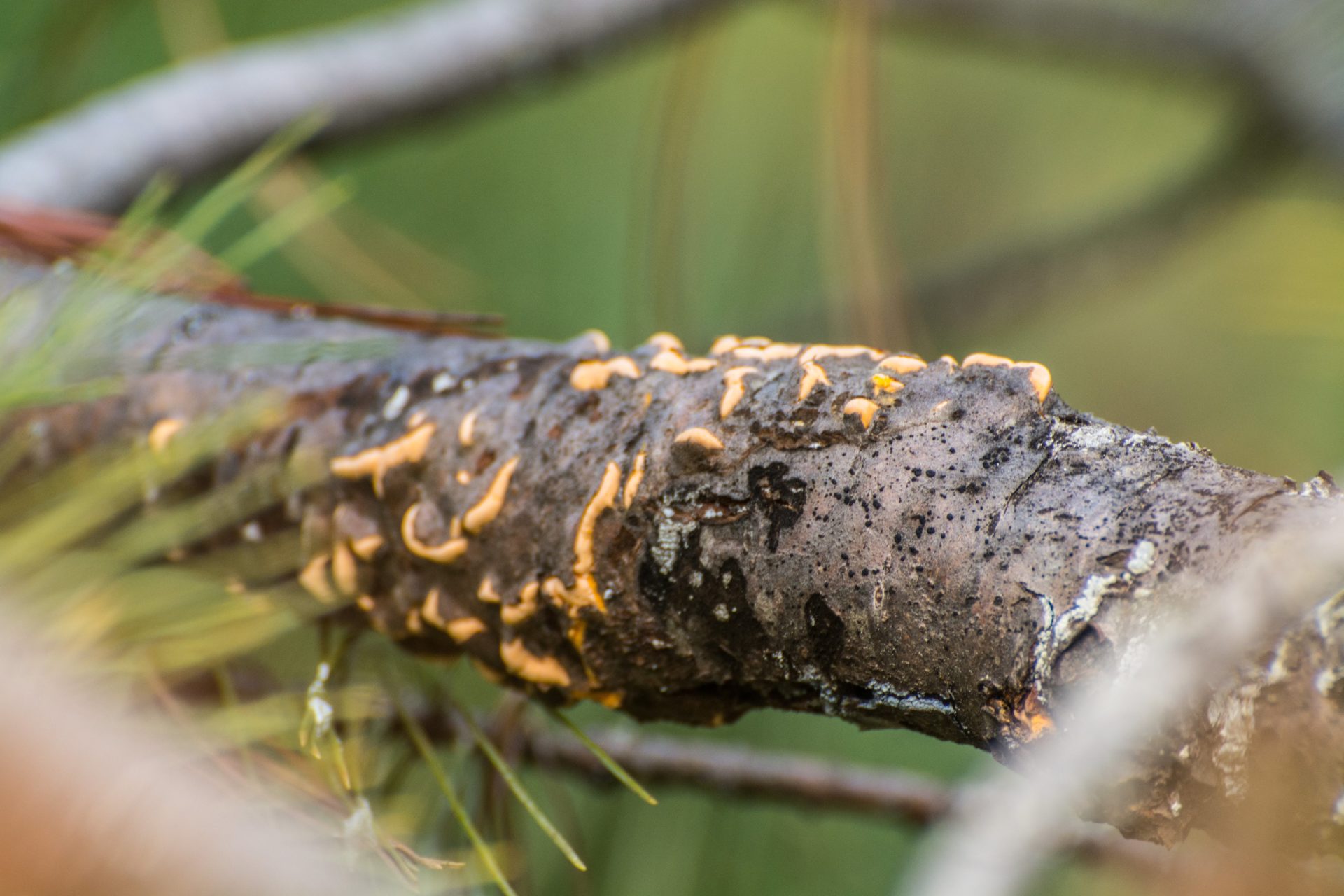
A whitebark pine shows signs of blister rust. Photo: Iain Reid
In the distance, the fast-moving clouds occasionally reveal glimpses of the Telkwa Range, a jagged row of mountains with glaciers spilling down their valleys. We hike through wet knee-high grass and wildflower, looking for another site where the researchers are trying to grow trees. They find it among a few other conifer species on a south-facing slope.
The women huddle over a seedling, both the tree and the scientists seemingly oblivious to the wind and rain. They’re looking at a bushy cluster of greenery just a couple of inches tall that grew where Clason planted seeds a few years ago.
“Alana was replicating a nutcracker cache, so she put five seeds in,” Haeussler says with the hint of a smile. “Very often you’ll get the whitebark pines in these clumps, up to 20 to 30 seedlings all growing together.”
Clason fiddles with the little bunch of greenery and estimates it to be at least three individuals. Her pride is like that of a parent.
“This is one of those ecosystems that it would be great if it could become iconic,” she says. “It just makes sense to us that it should.”
While the researchers love getting out in the field, much of the work is done behind the scenes, chasing funding, applying for grants, filing reports. While it’s an arduous process, Haeussler says it doesn’t frustrate her. “Well actually, you know, we just get super-psyched about our work.”
Randy Moody, a plant ecologist and chair of the Whitebark Pine Ecosystem Foundation of Canada, says Haeussler’s strength is not just science, it’s her way of looking at how to wrestle with conservation issues. “She’s not just going, ‘OK, the rust levels are high, this is a problem.’ She’s more thoughtful about how we frame this to resonate with people. It’s not just clinical, it’s more emotional, much more emotional than a lot of science.”
While Haeussler will always be passionate about whitebark pine, she is planning to pass the torch in the near future. Clason says she’s willing to take on the work when Haeussler steps back and is “recruiting a whitebark army, so that we can gear up and get out there to do the things that Sybille used to do.”
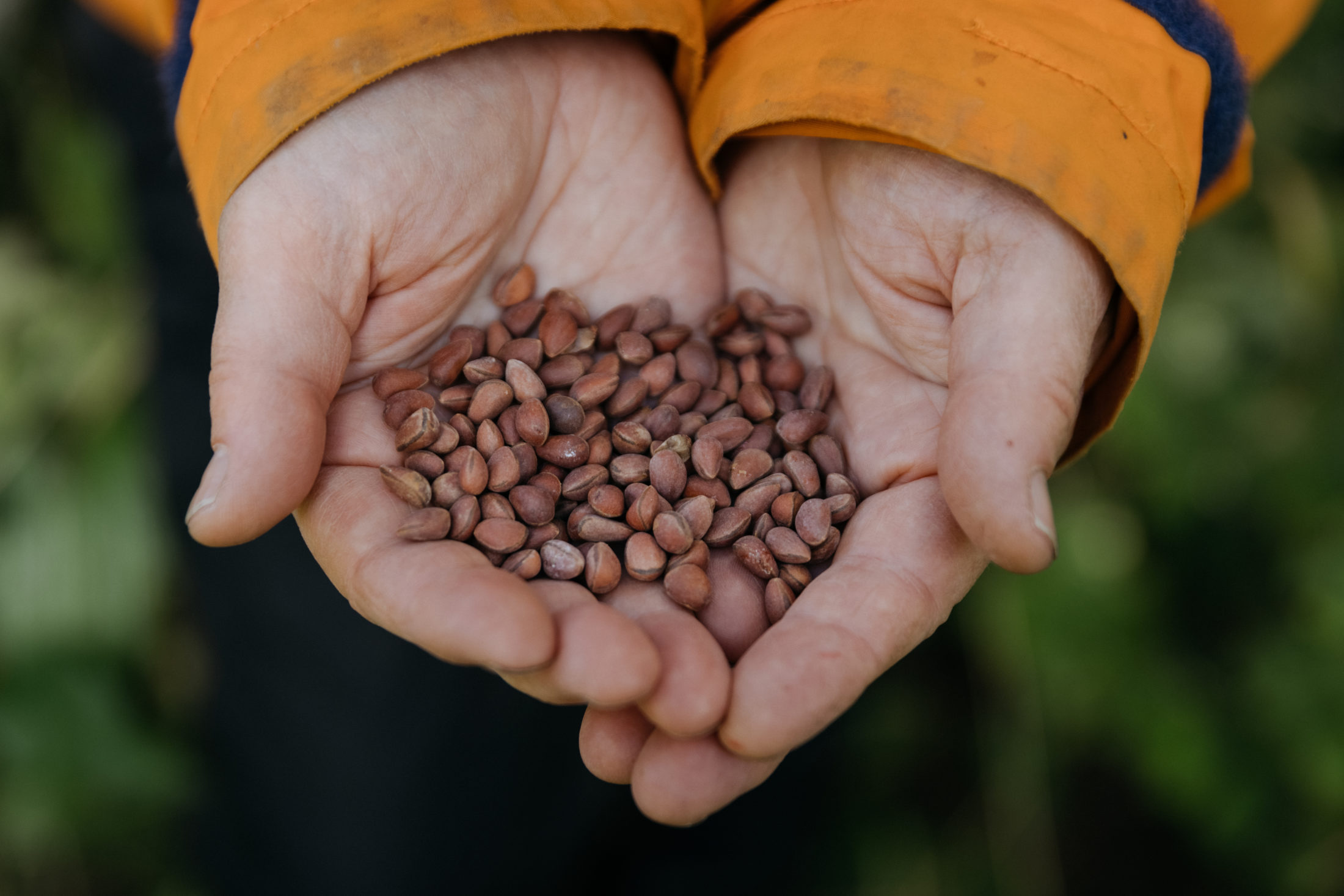
Sybille Haeussler holds whitebark pine seeds. Photo: Marty Clemens / The Narwhal
At the end of the day, the storm blows past and Haeussler leads the way back to her home at the base of the mountain. Wet gear steaming in the sudden sun, she pulls a tote out of the garage. Bags upon bags upon bags of reject seeds.
“You see, these are too small,” she says, picking up a seed. She explains they sometimes send the seeds away for X-ray to determine their viability. She and Clason half-joke about throwing these reject seeds out into a recent burn, where they might take root and thrive — or not.
Rejects or not, these whitebark pine seeds are emblematic of the entire ecosystem. With Clason watching, she carefully gathers a handful.
Enbridge Gas will face Waterloo Region in a hearing before the Ontario Energy Board to renew an agreement that would allow the company to continue...
Continue reading
For 15 years and counting, my commute from Mississauga to Toronto has been mired by...

For our last weekly newsletter of the year, we wanted to share some highlights from...

The fossil fuel giant says its agreement to build pipelines without paying for the right...